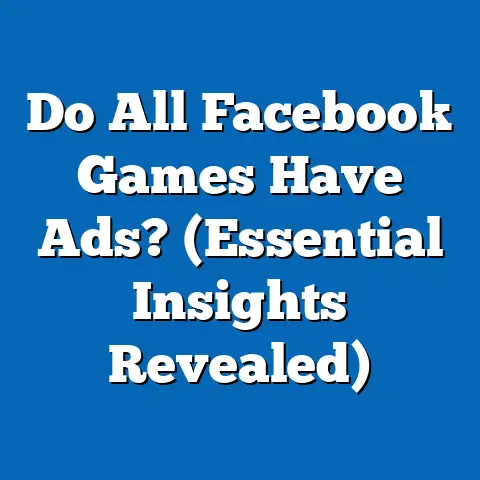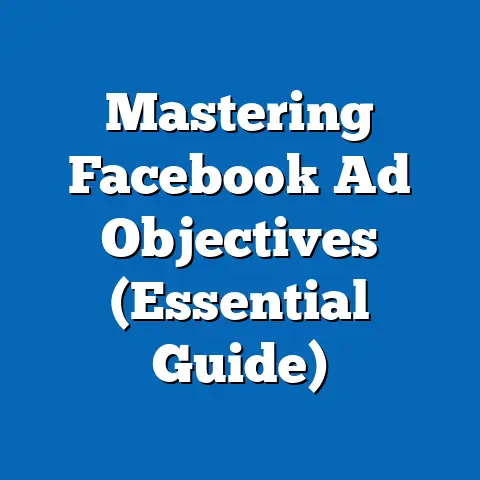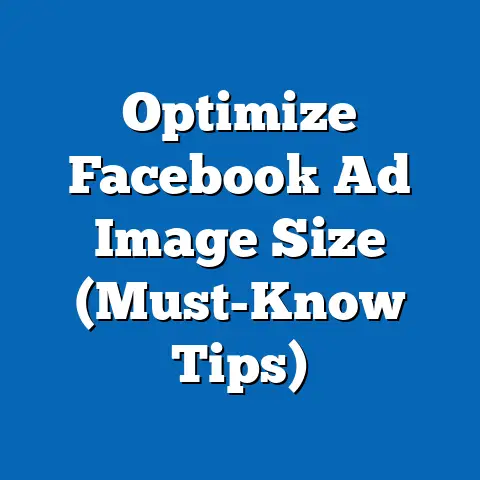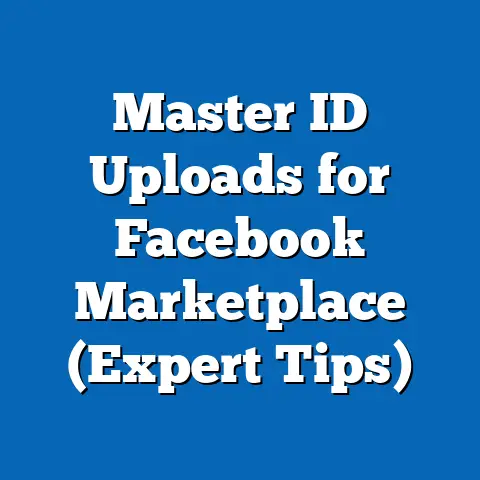Craft High-Impact Facebook Ads (Proven Strategies Unveiled)
In the ever-evolving digital marketing landscape, businesses are constantly grappling with a fundamental challenge: how to break through the noise and genuinely connect with their target audience amidst the endless stream of content on social media platforms. Facebook, with its staggering 2.8 billion active users, presents an immense opportunity for advertising. However, many brands find themselves struggling to create a lasting impact. The issue isn’t a lack of tools or resources; it’s about understanding how to craft high-impact Facebook ads that resonate with potential customers, foster engagement, and ultimately convert views into tangible sales.
I’ve seen firsthand how frustrating it can be for businesses pouring money into Facebook ads without seeing the desired results. I remember working with a local bakery that was spending a significant portion of their marketing budget on Facebook, but their ads were getting lost in the feed. They were using generic stock photos and bland copy that didn’t speak to their unique selling proposition – their delicious, handcrafted pastries. It was a classic case of throwing money at the problem without a clear strategy.
As competition intensifies and algorithms become more sophisticated, marketers are left questioning what truly makes an ad successful. How can you create Facebook ads that not only capture attention but also deliver measurable results? This article aims to unveil proven strategies that can revolutionize your Facebook advertising approach, providing you with the knowledge and techniques necessary to thrive in this dynamic marketplace. Let’s dive in and explore the secrets to crafting high-impact Facebook ads.
Understanding the Facebook Advertising Landscape
Facebook’s advertising platform is a powerhouse, offering unparalleled reach and targeting capabilities. It’s not just about throwing ads out there; it’s about understanding the ecosystem. For businesses, it’s crucial to grasp the importance of this platform and how it can be leveraged effectively.
-
Overview of Facebook’s Advertising Platform: Facebook Ads Manager is a comprehensive tool that allows businesses to create, manage, and track their ad campaigns. It offers various ad formats, targeting options, and bidding strategies to cater to diverse marketing objectives. From driving website traffic to generating leads, the platform is equipped to handle a wide range of goals.
-
Insights into User Behavior and Ad Engagement Statistics: Understanding how users interact with Facebook is key. According to recent studies, the average user spends around 34 minutes per day on Facebook. This presents a significant window of opportunity for businesses to capture their attention. However, attention spans are short, so ads need to be immediately engaging. Data shows that video ads tend to perform better than static images, and ads that offer value, such as discounts or helpful information, are more likely to be clicked.
-
The Impact of Facebook’s Algorithm on Ad Visibility and Performance: Facebook’s algorithm, often referred to as EdgeRank, plays a crucial role in determining which ads are shown to users. The algorithm considers factors such as the ad’s relevance, engagement rate, and quality score. Ads with high relevance and engagement are more likely to be shown to a wider audience at a lower cost.
Overview of Facebook’s Advertising Platform: Facebook Ads Manager is a comprehensive tool that allows businesses to create, manage, and track their ad campaigns. It offers various ad formats, targeting options, and bidding strategies to cater to diverse marketing objectives. From driving website traffic to generating leads, the platform is equipped to handle a wide range of goals.
Insights into User Behavior and Ad Engagement Statistics: Understanding how users interact with Facebook is key. According to recent studies, the average user spends around 34 minutes per day on Facebook. This presents a significant window of opportunity for businesses to capture their attention. However, attention spans are short, so ads need to be immediately engaging. Data shows that video ads tend to perform better than static images, and ads that offer value, such as discounts or helpful information, are more likely to be clicked.
The Impact of Facebook’s Algorithm on Ad Visibility and Performance: Facebook’s algorithm, often referred to as EdgeRank, plays a crucial role in determining which ads are shown to users. The algorithm considers factors such as the ad’s relevance, engagement rate, and quality score. Ads with high relevance and engagement are more likely to be shown to a wider audience at a lower cost.
Takeaway: Before launching any campaign, take the time to familiarize yourself with Facebook Ads Manager and understand the nuances of user behavior and the algorithm. This foundational knowledge will set you up for success.
Defining Your Target Audience
Effective advertising begins with a clear understanding of who you’re trying to reach. You can’t sell a product to everyone, and trying to do so will only waste your advertising budget. The more precisely you define your target audience, the more effective your ads will be.
-
The Significance of Audience Segmentation: Audience segmentation involves dividing your potential customers into smaller groups based on shared characteristics, such as demographics, interests, behaviors, and location. This allows you to tailor your ads to specific segments, making them more relevant and engaging.
-
Tools and Techniques for Identifying and Understanding Your Target Demographic: Facebook offers a range of tools for identifying and understanding your target demographic. Facebook Audience Insights provides valuable data on the demographics, interests, and behaviors of your potential customers. You can also use Facebook Pixel to track website visitors and create custom audiences based on their actions on your site.
I remember working with an e-commerce store that sold handmade jewelry. They were initially targeting a broad audience of women aged 25-55. By using Facebook Audience Insights, we discovered that their ideal customer was actually a woman aged 30-45 who was interested in sustainable fashion and supporting small businesses. By refining their targeting, we were able to significantly improve their ad performance.
-
Case Studies of Successful Campaigns: Many brands have achieved success by effectively targeting specific audiences. For example, Airbnb has successfully targeted travelers based on their interests and travel plans. They use custom audiences to retarget website visitors who have shown interest in specific destinations.
The Significance of Audience Segmentation: Audience segmentation involves dividing your potential customers into smaller groups based on shared characteristics, such as demographics, interests, behaviors, and location. This allows you to tailor your ads to specific segments, making them more relevant and engaging.
Tools and Techniques for Identifying and Understanding Your Target Demographic: Facebook offers a range of tools for identifying and understanding your target demographic. Facebook Audience Insights provides valuable data on the demographics, interests, and behaviors of your potential customers. You can also use Facebook Pixel to track website visitors and create custom audiences based on their actions on your site.
I remember working with an e-commerce store that sold handmade jewelry. They were initially targeting a broad audience of women aged 25-55. By using Facebook Audience Insights, we discovered that their ideal customer was actually a woman aged 30-45 who was interested in sustainable fashion and supporting small businesses. By refining their targeting, we were able to significantly improve their ad performance.
Case Studies of Successful Campaigns: Many brands have achieved success by effectively targeting specific audiences. For example, Airbnb has successfully targeted travelers based on their interests and travel plans. They use custom audiences to retarget website visitors who have shown interest in specific destinations.
Takeaway: Don’t skip the audience research! Invest time in understanding your target demographic. Use Facebook’s tools to gather data and refine your targeting. The more specific you are, the better your results will be.
Crafting Compelling Ad Copy
Once you know who you’re targeting, you need to craft ad copy that grabs their attention and compels them to take action. Your ad copy is your sales pitch, and it needs to be persuasive, engaging, and relevant.
-
Elements of Persuasive Ad Copy: Persuasive ad copy typically includes a compelling headline, a clear value proposition, and a strong call-to-action. The headline should grab the reader’s attention and make them want to learn more. The value proposition should clearly explain the benefits of your product or service. The call-to-action should tell the reader exactly what you want them to do (e.g., “Shop Now,” “Learn More,” “Sign Up”).
-
The Role of Storytelling: Storytelling can be a powerful tool for creating emotional connections with potential customers. By sharing stories about your brand, your products, or your customers, you can create a sense of empathy and build trust.
I once worked with a non-profit organization that was struggling to raise donations through Facebook ads. We decided to focus on storytelling and share personal stories of people who had benefited from their services. The response was overwhelming. People were moved by the stories and were much more likely to donate.
-
Examples of High-Impact Headlines and CTAs: Here are a few examples of high-impact headlines and call-to-actions:
- Headline: “Tired of Sleepless Nights? Discover Our Natural Sleep Aid!”
- Call-to-Action: “Get Your Free Trial Today!”
- Headline: “Transform Your Body in 30 Days!”
- Call-to-Action: “Join Our Challenge Now!”
Elements of Persuasive Ad Copy: Persuasive ad copy typically includes a compelling headline, a clear value proposition, and a strong call-to-action. The headline should grab the reader’s attention and make them want to learn more. The value proposition should clearly explain the benefits of your product or service. The call-to-action should tell the reader exactly what you want them to do (e.g., “Shop Now,” “Learn More,” “Sign Up”).
The Role of Storytelling: Storytelling can be a powerful tool for creating emotional connections with potential customers. By sharing stories about your brand, your products, or your customers, you can create a sense of empathy and build trust.
I once worked with a non-profit organization that was struggling to raise donations through Facebook ads. We decided to focus on storytelling and share personal stories of people who had benefited from their services. The response was overwhelming. People were moved by the stories and were much more likely to donate.
Examples of High-Impact Headlines and CTAs: Here are a few examples of high-impact headlines and call-to-actions:
- Headline: “Tired of Sleepless Nights? Discover Our Natural Sleep Aid!”
- Call-to-Action: “Get Your Free Trial Today!”
- Headline: “Transform Your Body in 30 Days!”
- Call-to-Action: “Join Our Challenge Now!”
Takeaway: Your ad copy is your chance to make a strong impression. Focus on crafting persuasive headlines, clear value propositions, and strong calls-to-action. Don’t be afraid to use storytelling to create emotional connections with your audience.
Designing Eye-Catching Visuals
In the fast-paced world of social media, visuals are king. People are more likely to stop scrolling for an image or video than for a block of text. Your visuals need to be eye-catching, relevant, and aligned with your brand identity.
-
The Psychology of Color and Imagery: Color and imagery can have a powerful impact on emotions and behavior. Certain colors are associated with specific emotions (e.g., blue with trust, red with excitement). Images should be high-quality, relevant to your product or service, and aligned with your brand’s aesthetic.
-
Best Practices for Creating Engaging Visuals: Here are a few best practices for creating engaging visuals:
- Use high-quality images and videos.
- Choose visuals that are relevant to your target audience.
- Use bright, eye-catching colors.
- Include people in your visuals (if appropriate).
- Keep your visuals simple and uncluttered.
-
A/B Testing Visuals: A/B testing involves creating two versions of an ad with different visuals and then testing which version performs better. This allows you to determine what resonates best with your audience.
The Psychology of Color and Imagery: Color and imagery can have a powerful impact on emotions and behavior. Certain colors are associated with specific emotions (e.g., blue with trust, red with excitement). Images should be high-quality, relevant to your product or service, and aligned with your brand’s aesthetic.
Best Practices for Creating Engaging Visuals: Here are a few best practices for creating engaging visuals:
- Use high-quality images and videos.
- Choose visuals that are relevant to your target audience.
- Use bright, eye-catching colors.
- Include people in your visuals (if appropriate).
- Keep your visuals simple and uncluttered.
A/B Testing Visuals: A/B testing involves creating two versions of an ad with different visuals and then testing which version performs better. This allows you to determine what resonates best with your audience.
Takeaway: Don’t underestimate the power of visuals. Invest in high-quality images and videos that are relevant to your target audience and aligned with your brand identity. Use A/B testing to determine what visuals perform best.
Utilizing Video in Facebook Ads
Video is one of the most engaging ad formats on Facebook. It allows you to convey your message in a dynamic and compelling way. With the rise of short-form video content, it’s more important than ever to incorporate video into your Facebook advertising strategy.
-
The Growing Trend of Video Content: Video content is becoming increasingly popular on social media. People are more likely to watch a video than read a block of text. According to recent statistics, video ads have a higher click-through rate (CTR) and conversion rate than static image ads.
-
Tips for Creating Short, Impactful Videos: Here are a few tips for creating short, impactful videos:
- Keep your videos short (ideally under 30 seconds).
- Grab the viewer’s attention in the first few seconds.
- Use clear and concise messaging.
- Include a strong call-to-action.
- Use subtitles (many people watch videos with the sound off).
-
Metrics to Measure the Success of Video Ads: Key metrics to track for video ads include:
- Video Views: The number of times your video has been viewed.
- Video Completion Rate: The percentage of people who watched your video to the end.
- Engagement Rate: The number of likes, comments, and shares your video has received.
- Click-Through Rate (CTR): The percentage of people who clicked on your video ad.
- Conversion Rate: The percentage of people who took a desired action after watching your video ad (e.g., made a purchase, signed up for a newsletter).
The Growing Trend of Video Content: Video content is becoming increasingly popular on social media. People are more likely to watch a video than read a block of text. According to recent statistics, video ads have a higher click-through rate (CTR) and conversion rate than static image ads.
Tips for Creating Short, Impactful Videos: Here are a few tips for creating short, impactful videos:
- Keep your videos short (ideally under 30 seconds).
- Grab the viewer’s attention in the first few seconds.
- Use clear and concise messaging.
- Include a strong call-to-action.
- Use subtitles (many people watch videos with the sound off).
Metrics to Measure the Success of Video Ads: Key metrics to track for video ads include:
- Video Views: The number of times your video has been viewed.
- Video Completion Rate: The percentage of people who watched your video to the end.
- Engagement Rate: The number of likes, comments, and shares your video has received.
- Click-Through Rate (CTR): The percentage of people who clicked on your video ad.
- Conversion Rate: The percentage of people who took a desired action after watching your video ad (e.g., made a purchase, signed up for a newsletter).
Takeaway: Video is a powerful tool for engaging your audience and driving results. Focus on creating short, impactful videos that grab attention, convey your message clearly, and include a strong call-to-action.
Leveraging Facebook Ad Formats
Facebook offers a variety of ad formats to suit different marketing objectives. Understanding the different formats and how to use them effectively is crucial for maximizing your advertising ROI.
-
Overview of Various Ad Formats: Some of the most popular ad formats include:
- Image Ads: Single image ads that are simple and effective for driving traffic to your website.
- Video Ads: Engaging video ads that can be used to tell your brand’s story or showcase your products.
- Carousel Ads: Ads that allow you to showcase multiple images or videos in a single ad unit.
- Collection Ads: Ads that are designed to drive sales and showcase a collection of products.
- Lead Ads: Ads that allow you to collect leads directly on Facebook.
- Instant Experience Ads: Full-screen mobile ads that provide an immersive experience for users.
-
Pros and Cons of Different Formats: Each ad format has its own pros and cons. For example, image ads are simple to create but may not be as engaging as video ads. Carousel ads are great for showcasing multiple products, but they may be more expensive than single image ads.
-
Real-Life Examples of Brands: Sephora has successfully used Collection ads to showcase their products and drive sales. They create visually appealing ads that feature a collection of products and then direct users to their website to make a purchase.
Overview of Various Ad Formats: Some of the most popular ad formats include:
- Image Ads: Single image ads that are simple and effective for driving traffic to your website.
- Video Ads: Engaging video ads that can be used to tell your brand’s story or showcase your products.
- Carousel Ads: Ads that allow you to showcase multiple images or videos in a single ad unit.
- Collection Ads: Ads that are designed to drive sales and showcase a collection of products.
- Lead Ads: Ads that allow you to collect leads directly on Facebook.
- Instant Experience Ads: Full-screen mobile ads that provide an immersive experience for users.
Pros and Cons of Different Formats: Each ad format has its own pros and cons. For example, image ads are simple to create but may not be as engaging as video ads. Carousel ads are great for showcasing multiple products, but they may be more expensive than single image ads.
Real-Life Examples of Brands: Sephora has successfully used Collection ads to showcase their products and drive sales. They create visually appealing ads that feature a collection of products and then direct users to their website to make a purchase.
Takeaway: Experiment with different ad formats to see what works best for your business. Consider your marketing objectives and target audience when choosing an ad format.
Implementing Advanced Targeting Techniques
Facebook’s advanced targeting options allow you to reach a highly specific audience based on their demographics, interests, behaviors, and connections. Leveraging these techniques can significantly improve your ad performance.
-
An Introduction to Advanced Targeting Options: Some of the most powerful advanced targeting options include:
- Custom Audiences: Allows you to target people who have interacted with your business in the past (e.g., website visitors, email subscribers, app users).
- Lookalike Audiences: Allows you to target people who are similar to your existing customers.
- Interest-Based Targeting: Allows you to target people based on their interests and hobbies.
- Behavior-Based Targeting: Allows you to target people based on their online behavior (e.g., purchase history, travel habits).
-
How to Effectively Use These Features: To effectively use advanced targeting features, you need to have a clear understanding of your target audience. Use Facebook Audience Insights to gather data and refine your targeting criteria.
-
Success Stories: Many brands have achieved success by using advanced targeting strategies. For example, a clothing retailer used lookalike audiences to target people who were similar to their existing customers and saw a significant increase in sales.
An Introduction to Advanced Targeting Options: Some of the most powerful advanced targeting options include:
- Custom Audiences: Allows you to target people who have interacted with your business in the past (e.g., website visitors, email subscribers, app users).
- Lookalike Audiences: Allows you to target people who are similar to your existing customers.
- Interest-Based Targeting: Allows you to target people based on their interests and hobbies.
- Behavior-Based Targeting: Allows you to target people based on their online behavior (e.g., purchase history, travel habits).
How to Effectively Use These Features: To effectively use advanced targeting features, you need to have a clear understanding of your target audience. Use Facebook Audience Insights to gather data and refine your targeting criteria.
Success Stories: Many brands have achieved success by using advanced targeting strategies. For example, a clothing retailer used lookalike audiences to target people who were similar to their existing customers and saw a significant increase in sales.
Takeaway: Don’t limit yourself to basic targeting options. Explore Facebook’s advanced targeting features to reach a highly specific audience and improve your ad performance.
Analyzing and Optimizing Ad Performance
The key to successful Facebook advertising is continuous analysis and optimization. You need to track your ad performance, identify what’s working and what’s not, and make adjustments accordingly.
-
Key Performance Indicators (KPIs): Some of the most important KPIs to track for Facebook ads include:
- Reach: The number of people who have seen your ad.
- Impressions: The number of times your ad has been displayed.
- Click-Through Rate (CTR): The percentage of people who clicked on your ad.
- Cost Per Click (CPC): The average cost you pay for each click on your ad.
- Conversion Rate: The percentage of people who took a desired action after clicking on your ad (e.g., made a purchase, signed up for a newsletter).
- Return on Ad Spend (ROAS): The amount of revenue you generate for every dollar you spend on advertising.
-
Tools for Monitoring and Analyzing Ad Performance: Facebook Ads Manager provides a range of tools for monitoring and analyzing your ad performance. You can also use third-party analytics tools to gain deeper insights into your data.
-
Strategies for Continuous Improvement: Based on your data, you can make adjustments to your ad campaigns to improve performance. This might involve refining your targeting, tweaking your ad copy, or changing your visuals.
Key Performance Indicators (KPIs): Some of the most important KPIs to track for Facebook ads include:
- Reach: The number of people who have seen your ad.
- Impressions: The number of times your ad has been displayed.
- Click-Through Rate (CTR): The percentage of people who clicked on your ad.
- Cost Per Click (CPC): The average cost you pay for each click on your ad.
- Conversion Rate: The percentage of people who took a desired action after clicking on your ad (e.g., made a purchase, signed up for a newsletter).
- Return on Ad Spend (ROAS): The amount of revenue you generate for every dollar you spend on advertising.
Tools for Monitoring and Analyzing Ad Performance: Facebook Ads Manager provides a range of tools for monitoring and analyzing your ad performance. You can also use third-party analytics tools to gain deeper insights into your data.
Strategies for Continuous Improvement: Based on your data, you can make adjustments to your ad campaigns to improve performance. This might involve refining your targeting, tweaking your ad copy, or changing your visuals.
Takeaway: Don’t set it and forget it! Regularly monitor your ad performance and make adjustments to improve your results. Use data to guide your decisions and continuously optimize your campaigns.
Staying Updated on Facebook Advertising Trends
The world of Facebook advertising is constantly changing. New features are introduced, algorithms are updated, and best practices evolve. To stay ahead of the curve, it’s important to stay informed and adapt to the latest trends.
-
The Importance of Adapting: What worked last year might not work today. You need to be willing to experiment with new strategies and adapt to changes in the platform.
-
Resources and Communities: There are many resources and communities to follow for the latest updates on Facebook ads. Some popular resources include:
- Facebook’s official blog
- Industry blogs and websites (e.g., Social Media Examiner, AdEspresso)
- Online forums and communities (e.g., Reddit’s r/FacebookAds)
-
Predictions for the Future: The future of Facebook advertising is likely to be more personalized, automated, and data-driven. As AI and machine learning become more sophisticated, we can expect to see more advanced targeting options, automated bidding strategies, and personalized ad experiences.
The Importance of Adapting: What worked last year might not work today. You need to be willing to experiment with new strategies and adapt to changes in the platform.
Resources and Communities: There are many resources and communities to follow for the latest updates on Facebook ads. Some popular resources include:
- Facebook’s official blog
- Industry blogs and websites (e.g., Social Media Examiner, AdEspresso)
- Online forums and communities (e.g., Reddit’s r/FacebookAds)
Predictions for the Future: The future of Facebook advertising is likely to be more personalized, automated, and data-driven. As AI and machine learning become more sophisticated, we can expect to see more advanced targeting options, automated bidding strategies, and personalized ad experiences.
Takeaway: Stay curious and keep learning! The world of Facebook advertising is constantly evolving, so it’s important to stay informed and adapt to the latest trends.
Conclusion: The Path Forward
Navigating the complexities of Facebook advertising requires a strategic approach. By focusing on the elements outlined in this article – defining your target audience, crafting compelling copy, designing eye-catching visuals, leveraging innovative formats, and rigorously analyzing performance – you can create high-impact Facebook ads that not only engage but also convert.
Remember the bakery I mentioned at the beginning? By implementing these strategies, we were able to transform their Facebook ads. We refined their targeting, created visually appealing ads that showcased their delicious pastries, and crafted compelling copy that spoke to their target audience. The result? A significant increase in website traffic, leads, and ultimately, sales.
The key is continual learning and adaptation, ensuring that your advertising efforts remain relevant and effective in a competitive landscape. Embrace the challenge, stay curious, and you’ll be well on your way to crafting high-impact Facebook ads that drive real results for your business. So, take these strategies, experiment, and watch your Facebook advertising efforts flourish!






